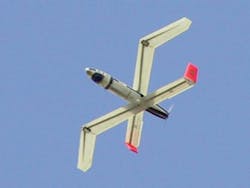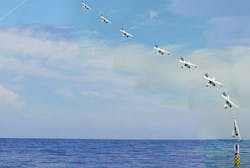Navy demonstrates ability to launch surveillance UAVs stealthily from submerged submarines
Officials of the Naval Research Laboratory (NRL) in Washington on Thursday announced they have demonstrated the launch of an all-electric, fuel cell-powered, unmanned aerial vehicle (UAV) from the fast attack submarine USS Providence ((SSN 719) while the submarine was underwater.
The drone involved was the NRL-developed Experimental Fuel Cell Unmanned Aerial System (XFC UAS), a folding-wing UAV launched vertically from a Sea Robin launch vehicle, which itself was launched from a Tomahawk cruise missile launch cannister inside a torpedo tube aboard the Providence, a Los Angeles-class attack submarine -- one of the smallest submarines in the U.S. subsurface forces.
This configuration of the Sea Robin launch vehicle and Tomahawk launch canister launched from a torpedo tube also could be employed aboard Navy Virginia-class attack submarines, Seawolf attack submarine, and Ohio-class ballistic-missile and cruise-missile submarines.
During the test aboard the Providence off the U.S. East Coast, the Sea Robin launch vehicle containing the XFC UAS rose to the ocean surface after discharging from the torpedo tube. When the package reached the surface, it appeared as a spar buoy.
On command from the Providence's commanding officer, the XFC UAS vertically launched from surfaced Sea Robin and flew for several hours demonstrating live video capabilities streamed back to the submarine, as well as to surface support vessels and naval command authorities in Norfolk, Va., before landing at a Navy base Andros, Bahamas. The folding-wing UAV autonomously deploys its X-wing airfoil after launch and flies horizontally.
The successful submerged launch of a remotely deployed UAV offers a pathway to providing mission critical intelligence, surveillance and reconnaissance (ISR) capabilities to the U.S. Navy's submarine force, Navy officials say.
In the future, U.S. military authorities envision a fleet of large unmanned underwater vehicles (UUVs) able to deploy smaller UUVs and UAVs for global reconnaissance and attack capability. The UAV-launch demonstration aboard the Providence is one of the first steps toward that goal.
The NRL team responsible for the test includes the design-builder of the Sea Robin, Oceaneering International Inc. in Hanover, Md.; and the fuel cell developer Protonex Technology Corp. in Southborough, Mass.
The XFC is a fully autonomous, all electric fuel cell powered folding wing UAS with an endurance of greater than six hours, Navy officials say. The non-hybridized power plant supports the propulsion system and payload for a flight endurance that enables relatively low cost, low altitude, ISR missions.
The XFC UAS first flew in June 2009, when it was airborne for more than six hours. NRL's Chemistry and Tactical Electronic Warfare Divisions developed the XFC UAS as an expendable, long endurance ISR UAV.
Compared to internal-combustion-powered UAVs, battery powered unmanned aircraft are inherently stealthy because they are relatively free of noise and thermal signature, and are easy to start, operate, and maintain.
Their weakness, however, involves their relatively poor payload capacity and endurance. The electrically powered UAV could have more tactical utility if endurance could be increased, Navy officials say. The XFC UAS program is addressing these issues with a hydrogen fuel cell power plant.
For more information contact the Naval Research Laboratory online at www.nrl.navy.mil.

